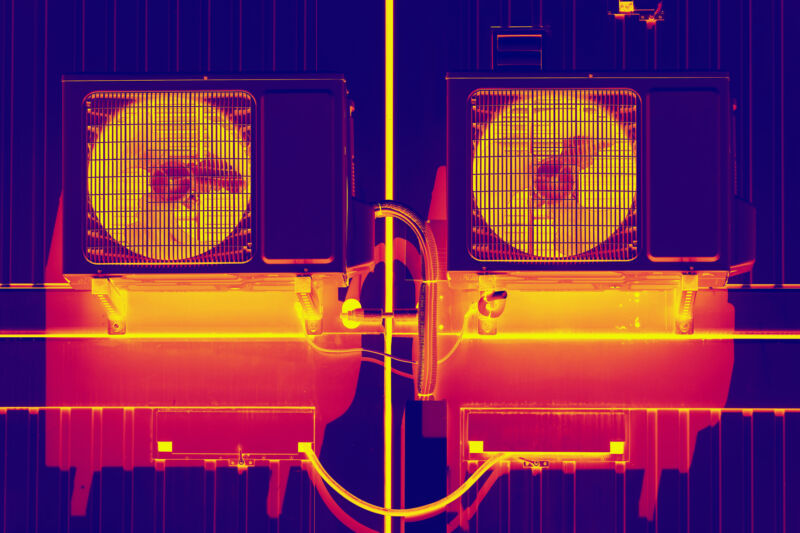feel the heat —
Nine states are teaming up to accelerate adoption of this climate-friendly device.

Death is coming for the old-school gas furnace—and its killer is the humble heat pump. They’re already outselling gas furnaces in the US, and now a coalition of states has signed an agreement to supercharge the gas-to-electric transition by making it as cheap and easy as possible for their residents to switch.
Nine states have signed a memorandum of understanding that says that heat pumps should make up at least 65 percent of residential heating, air conditioning, and water-heating shipments by 2030. (“Shipments” here means systems manufactured, a proxy for how many are actually sold.) By 2040, these states—California, Colorado, Maine, Maryland, Massachusetts, New Jersey, New York, Oregon, and Rhode Island—are aiming for 90 percent of those shipments to be heat pumps.

“It’s a really strong signal from states that they’re committed to accelerating this transition to zero-emissions residential buildings,” says Emily Levin, senior policy adviser at the Northeast States for Coordinated Air Use Management (NESCAUM), an association of air-quality agencies, which facilitated the agreement. The states will collaborate, for instance, in pursuing federal funding, developing standards for the rollout of heat pumps, and laying out an overarching plan “with priority actions to support widespread electrification of residential buildings.”
Instead of burning planet-warming natural gas, a heat pump warms a building by transferring heat from the outdoor air into the interior space. Run it in the opposite direction, and it can cool the inside of a building—a heat pump is both a heater and AC unit. Because the system is electric, it can run off a grid increasingly powered by renewables like wind and solar. Even if you have to run a heat pump with electricity from fossil-fuel power plants, it’s much more efficient than a furnace, because it’s moving heat instead of creating it.
A heat pump can save an average American household over $550 a year, according to one estimate. They’ve gotten so efficient that even when it’s freezing out, they can still extract warmth from the air to heat a home. You can even install a heat pump system that also warms your water. “We really need consumers to move away from dirty to clean heat, and we really want to get the message out that heat pumps are really the way to go,” says Serena McIlwain, Maryland’s secretary of the environment. “We have homeowners who are getting ready to replace their furnaces, and if they’re not aware, they are not going to replace it with a heat pump.”
The coalition’s announcement comes just months after the federal government doubled down on its own commitment to heat pumps, announcing $169 million in funding for the domestic production of the systems. That money comes from 2022’s Inflation Reduction Act, which also provides an American household with thousands of dollars in rebates or tax credits to switch to a heat pump.
These states are aiming to further collaborate with those heat pump manufacturers by tracking sales and overall progress, sending a signal to the industry to ramp up production to meet the ensuing demand. They’ll also collaborate with each other on research and generally share information, working toward the best strategies for realizing the transition from gas to electric. Basically, they’re pursuing a sort of standardization of the policies and regulations for getting more heat pumps built, bought, and installed, which other states outside of the coalition might eventually tap into.
“A consistent approach between states helps to ease the market transition,” says Matt Casale, senior manager of appliance standards at the Building Decarbonization Coalition, which is collaborating with the Northeast States for Coordinated Air Use Management. “There are all of these manufacturers, and all of these contractors, all along the supply chain, trying to plan out their next several years. They want to know: What is it going to look like?”
There’s also the less-talked-about challenge of the green energy revolution: training enough technicians to actually install the heat pumps. To that end, the memorandum calls for workforce development and contractor training. “If we’re pushing heat pumps and more installations, and we don’t have enough electricians to do the job, we’re not going to meet the goal—period,” says McIlwain. “We do need to put a lot of money and energy and resources into making sure that we have the workforce available to do it.”
In addition to the technicians working with the systems, the country needs way more electricians to retrofit homes to go fully electric beyond heat pumps, with solar panels and induction stoves and home batteries. To help there, last year the White House announced the formation of the American Climate Corps, which aims to put more than 20,000 people to work in clean energy and overall climate resilience.
With states collaborating like this on heat pumps, the idea is to lift the device from an obscure technology cherished by climate nerds into ubiquity, for the good of consumers and the planet. “We need to be sending these unmistakable signals to the marketplace that heat pumps and zero-emission homes are the future,” says Casale. “This agreement between this many states really sets the stage for doing that.”
This story originally appeared on wired.com.